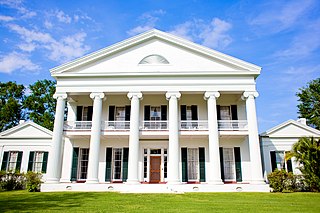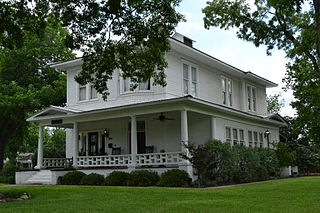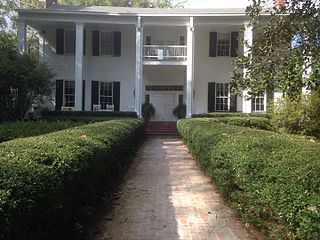
The Victorian Village District is an area of Memphis, Tennessee.

Madewood Plantation House, also known as Madewood, is a former sugarcane plantation house on Bayou Lafourche, near Napoleonville, Louisiana. It is located approximately two miles east of Napoleonville on Louisiana Highway 308. A National Historic Landmark, the 1846 house is architecturally significant as the first major work of Henry Howard, and as one of the finest Greek Revival plantation houses in the American South.

Pemberton's Headquarters, also known as the Willis-Cowan House, is a historic house museum at 1018 Crawford Street in Vicksburg, Mississippi. Built in 1836, it served as the headquarters for Confederate General John C. Pemberton during most of the 47-day siege of Vicksburg, and was the site where he decided to surrender the city to Union General Ulysses S. Grant on July 4, 1863. The house is owned by the National Park Service and is open to the public as part of Vicksburg National Military Park. The house was declared a National Historic Landmark in 1976.

The Colonel Robert A. Smith Monument, located in Hart County, Kentucky, is a monument related to the American Civil War, listed on the National Register of Historic Places. It was built in the memory of Colonel Robert A. Smith and the members of the 10th Mississippi Infantry Regiment who died in the service of the Confederate States of America on September 14, 1862, at the Battle of Munfordville.

The Richard Starcke House is a historic house located at 703 Main Street, Bastrop, Texas, United States. The house was built in 1913 by Richard Starcke, a prominent Bastrop businessman, for himself and his wife Mary.

The Landmark Inn State Historic Site is a historic inn in Castroville, Texas, United States. It serves the general public as both a state historic site and a bed & breakfast with eight overnight rooms.

The F. H. Miller House is a historic building located in the central part of Davenport, Iowa, United States. The house served as the official residence for two of Davenport's Catholic bishops and as a bed and breakfast. The building now houses the Office of Advancement and Alumni Relations for St. Ambrose University, and is called Alumni House. It has been listed on the National Register of Historic Places since 1983.

Hinchman-Lippincott House is located in Haddon Heights, Camden County, New Jersey, United States. The house was built in c. 1699 and added to the National Register of Historic Places on February 17, 1995.

The James Cant Ranch is a pioneer ranch complex in Grant County in eastern Oregon, United States. The ranch is located on both sides of the John Day River in the John Day Fossil Beds National Monument. The ranch was originally homesteaded by Floyd Officer in 1890. Officer sold the property to James Cant in 1910. Cant increased the size of the property and built a modern ranch complex on the west bank of the river. The National Park Service bought the ranch from the Cant family in 1975, and incorporated the property into the John Day Fossil Beds National Monument. The National Park Service used the main house as a visitor center until 2003. Today, the Cant Ranch complex is preserved as an interpretive site showing visitors an early 20th-century livestock ranch. The James Cant Ranch is listed on the National Register of Historic Places.

The Abner Davison House is one of several mansions that overlook the Mississippi River on the east side of Davenport, Iowa, United States. It has been listed on the National Register of Historic Places since 1984, and on the Davenport Register of Historic Properties since 1997.

The John H. Suiter House is a historic building located in Le Claire, Iowa, United States. The house was built in 1855 and it has been listed on the National Register of Historic Places since 1979. The property is part of the Houses of Mississippi River Men Thematic Resource, which covers the homes of men from LeClaire who worked on the Mississippi River as riverboat captains, pilots, builders and owners.

The C. R. Joy House, also known as The Grande Anne Bed & Breakfast, was a historic building located in Keokuk, Iowa, United States. It was destroyed by fire in July 2018. It was individually listed on the National Register of Historic Places in 1997. In 2002 it was included as a contributing property in The Park Place-Grand Avenue Residential District.

Walnut Grove is an historic Greek Revival-style house in Spotsylvania County, Virginia. The house was built in 1840 on land that was purchased by Jonathan Johnson in 1829. Markings on the exposed oak beams indicate that Walnut Grove was built by William A. Jennings. Jennings was recognized as a master builder of Greek Revival homes during that period. Walnut Grove was added to the National Register of Historic Places in August 2004.

The Col. Joseph Ellis House is located in Haddon Heights, Camden County, New Jersey, United States. The house was built in 1760, and was the dwelling of Revolutionary War hero Colonel Joseph Ellis. It was added to the National Register of Historic Places on September 23, 1994.

Four Mounds Estate Historic District is a nationally recognized historic district located in Dubuque, Iowa, United States. It was listed on the National Register of Historic Places in 2002. At the time of its nomination the district consisted of 19 resources, including 11 contributing buildings, two contributing sites, four non-contributing structures, and two non-contributing buildings. The estate is named for the four conical burial mounds that are located on the property. They are one of the historic sites, and they are individually listed on the National Register of Historic Places.

The John Holliday House, also known as Holliday Haven. is a historic mansion in Aberdeen, Mississippi, U.S.. It was built in the 1850s for John Holliday, a North Carolinian who owned a plantation west of Aberdeen called Holliday Place. It was designed in the Greek Revival architectural style. It has been listed on the National Register of Historic Places since February 22, 1988.

The Charles Ready House, also known as The Corners, is a historic house in Readyville, Tennessee, United States. It is located in Cannon County, on the border of Rutherford County.

The Ervin Lewis House is a historic mansion in Byram, Mississippi, U.S.. It was built for John Coon prior to the American Civil War As Coon came from the North, the Union Army did not destroy it during the war. It was purchased by Ervin Lewis, who was from South Carolina, after the war. It was designed in the Greek Revival architectural style. It has been listed on the National Register of Historic Places since December 1, 1989.

Sub Rosa is a historic mansion in Pocahontas, Mississippi, U.S.. It was built for John and Margaret Greaves from 1852 to 1854, and it was designed in the Greek Revival architectural style. In 1870, in the aftermath of the American Civil War, the Greaves moved to Los Angeles, California and rented Sub Rosa to Jim Bostick. The house has been listed on the National Register of Historic Places since April 28, 1975.

The Heman L. Ticknor House is a historic house in Anoka, Minnesota, United States. It was originally built in 1867 in Gothic Revival style, then remodeled multiple times in the early 20th century to accrue substantial Queen Anne and Neoclassical elements. The Ticknor House was listed on the National Register of Historic Places in 1979 for its local significance in the themes of architecture, commerce, and exploration/settlement. It was nominated for its association with three generations of an influential local family and its representation of their evolving architectural tastes.





















